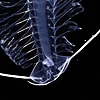HOME | DD
 KingDilophosaurus — Snaggletooth dog eel
KingDilophosaurus — Snaggletooth dog eel

#fish #marine #worldbuilding #spec_evo #worldbuildingart #alien #aliencreature #alienspecies #creaturedesign #species #xenobiology #creatureconcept #speculativeevolution #speculativebiology #speculativezoology #specevo #world_building #worldbuildingspecies
Published: 2024-01-10 07:47:54 +0000 UTC; Views: 4586; Favourites: 113; Downloads: 5
Redirect to original
Description
Much of the predators resident to the carpgrass prairie often hunt during the day, when visibility is optimal due to the light from Amaterasu (the sun) illuminating the seas. It is also the time when most pelagys are awake and swimming about, making finding prey a lot more easier. Due to this, competition is fierce between predators who seek prey during the daytime, forcing niche partitioning among the species, with some being a lot more specialised than others. Some predators, however, may avoid competition altogether by hunting when the sun comes down: the nighttime.These nocturnal predators often express much different body plans than diurnal predators, trading speed and agility common in species like aeunas, for more slender and manoeuvrable forms in order to find prey hidden in the carpgrass, burrows or nooks and crannies within rocks. And among the most successful and common nocturnal predators are the eucinetophiformes. The earliest-diverging group of pelagys, they are identifiable for their thin, slender bodies, exposed reproductive filaments and completely smooth skin and a caudal rhachis along the entire length of the tail, giving them an appearance similar to eels. Most species are small, like the bandy-dandy, but some can grow quite large, with the snaggletooth dog eel being one of the most common large eucinetophiformes, growing up to a metre in length.
The snaggletooth dog eel, the only member of its genus, is a common nocturnal predator in northern Bionesia and Pulau Kecil, often seen resting on the sea floor in holes and burrows, or simply in the carpgrass during the day, and is known to be quite timid, avoiding predators and minding its own business. Naturally, they are often seen resting together in masses, oblivious to potential prey items, only expressing aggression if disturbed or annoyed. While being predators, it seems that they don't show much interest to food, which is quite unusual. However, once the sunlight dims and soon creeps below the horizon, heralding the approach of the night sky, where darkness covers the land, things take a different direction for the sleeping pelagys who seek solace and safety in nooks and crannies in rocks, burrows in the sand or among the carpgrass prairies.
During the night, the snaggletooth dog eel completely changes in behaviour, like a flick of a switch from daytime to nighttime. If the snaggletooth dog eel were Dr. Jekyll during the day, then during the night, they would be Mr. Hyde. No longer are they placid and oblivious, they are now aggressive and actively seeking out prey. They know that pelagys hide in burrows and other types of holes and crevices in rocks and sediment, and use their slimy and thin bodies to worm their way into holes in order to flush out prey, which they capture with their sharp, knife-like teeth. When hunting, their aggressive, frenzied behaviour can translate to groups of hundreds of dog eels fighting to try to enter a hole to gain access to the prey inside. They fight amongst themselves, coiling themselves around each other and biting each other in violent bouts to find food. This extremely aggressive method of hunting stems from the fact that they usually rest together in the day, which means one area might be home to over 30 individuals which will fight each other in order to gain access to prime spots. Their elongated and slender form is perfectly adapted for flushing out sleeping prey, with their large snouts (most eucinetophiformes have short snouts and completely smooth beaks) allowing them to sense movement in tight areas with great efficiency. They also look for carcasses of large pelagys, such as gallantees, in which they coil around the corpse in order to tear off a chunk of meat. Each night, they hunt in massive frenzies, seeking as much food they can gather in the night. However, every night must end, and when the sun rises up, the sunlight signals to these voracious hunters that their time is over, and they must return to their placid life, resting in the carpgrass, avoiding the daytime predators, waiting for the night to come, so that they can hunt under the cover of the shadows once more.

















